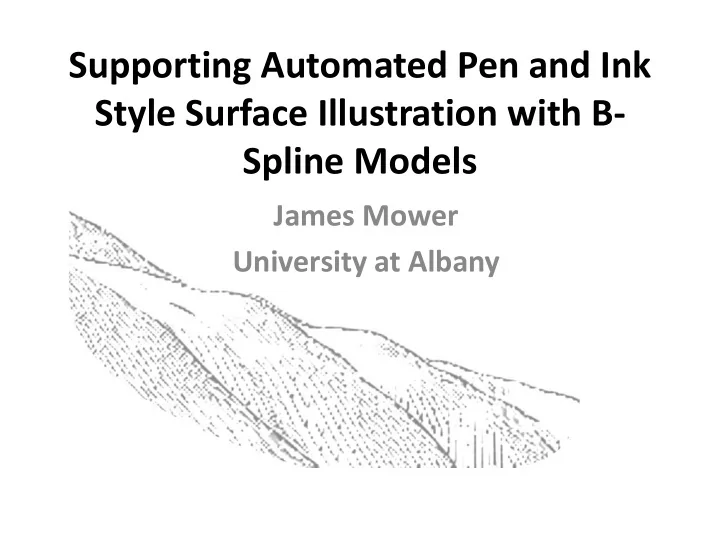

Supporting Automated Pen and Ink Style Surface Illustration with B- Spline Models James Mower University at Albany
Perspective Landscape Rendering • Demonstrated in Tuscan landscape paintings by da Vinci • Extended to woodcuts in the 16 th century by Murer and others Study of a Tuscan Landscape, Da Vinci, ca. 1473 Section of Map of Zurich, Murer, 1566
Geomorphological Illustrators
Automating Pen and Ink Illustration • Apply a non-photorealistic rendering (NPR) approach • Use an “economy of lines” – Markosian and others, 1997 • Depict the essential form of an object using a minimal number of strokes
Linework • Landscape features are represented with 2 types of linework – Silhouettes • Boundaries between visible and invisible surfaces – Form Lines W.M. Davis • Surface trends
Representing Elevation • More samples, less interpolation • TIN • Polyhedron • Interpolated values lie on plane • Fewer samples, more interpolation • “Global” polynomial functions of order p • Polynomial patches of order p • Interpolated values evaluate to degree p-1 surface
But Which Is Best? • Manual pen and ink style landscape illustrations usually depict low noise surfaces • Dense sampling models have lots of noise • Some NPR techniques are sensitive to noise – Can generate numerous junk silhouettes • Bezier surface models supress noise and are good candidates for NPR support
Surface Noise and Silhouettes
Bezier Surface Models • A Bezier surface is described by control points • Its order in u and v equals the number of control points along the respective axes • Each control point is associated with a basis function • The basis function determines the control point’s influence on the surface at position u,v
A Bezier Surface A degree 3 by degree 3 Bezier Surface Generated from a Java applet created by David Little, Department of Mathematics, Penn State
A Problem with Bezier Surfaces • Evaluation times increase exponentially with the number of control points • Computations on large numbers of control points can lead to numerical overflow • Solution — B-Spline surfaces – A patchwork of low order Bezier surfaces – Stitched together at their edges with continuous joins
B-Spline Surface Model • Composed of local ‘basis’ functions that only contribute within a given ‘knot span’ • The continuity at the joins is determined by: – The degree of the basis functions in u and v – The number of duplicate knot values at the join • This project uses degree 3 basis functions with 2 times differentiability at the joins
A B-Spline Surface 10 degree 3 by degree 3 patches are stitched together with 2 times differentiability at patch borders
Surface Tessellation • Polynomial surfaces are rendered as a set of planar facets (a tessellation) • The facets should cover about the same screen space, regardless of their position in the world • The OpenGL B-spline rendering functions enforce this criterion
Gray Shaded B-Spline Surface Rendering this surface in emissive white makes it a useful surface mask for silhouette and form line rendering
Surface Processing Environment • OpenGL – NURBS (non-uniform, rational B-spline) package • CGAL – Computational Geometry and Algorithms Library – Triangulation facilities – Useful geometric modeling operations and primitives • Written in C++ for MS Windows
Extracting Silhouettes
Silhouettes and a Masking Surface
Defining Form Lines • A form line shows a surface trend • Form lines can be defined globally or locally • This project defines a form line segment as a line of steepest descent from one vertex to an adjacent neighbor – Form lines are visual composites of locally generated segments
The Form Line Model The weighted illumination and slope components control shading for a surface facet
Using Drainage Accumulation Models • Lines of steepest descent are assembled into a stream network • Each branch of the network has a stream order • Segments can be displayed or hidden by order Simulated Effect
Form Line Example
Rendering Parameters • Illumination azimuth and altitude • Position and attitude of the viewpoint • Variable form line width with slope and illumination angles • Form line display by stream order • Adjustable weighting of all parameters
Varying Illumination Azimuth West Temple feature, Zion National Park 72 images, illumination azimuth rotating through 360 degrees at 5 degrees per image
Level of Detail Varies with the Viewpoint Position 100 still images on an 8 km flight path
When Less is More • This W.M. Davis image uses very few strokes • The following slide shows how a landscape can be rendered with fewer strokes
A Low Relief Environment • This is from a coastal scene in Labrador – DEM provided by Rudy Slingerlands at Penn State • Not as minimal as Davis, but getting there…
Performance Issues and a New Approach • Building silhouette and drainage models with CGAL from NURBS models is very slow – The Utah images take 5 to 10 minutes per frame • New OpenGL versions allow tessellation control with shader programs • Shader programs run on the GPU and can be very fast
Preliminary GPU Results • Now doing B-spline modeling on the GPU • Silhouettes are interpreted as borders between rendered pixels generated from non 3D-contiguous parent triangles • Speeds are approaching animation time scale
Thanks for Coming! • A couple recent papers are at http://www.albany.edu/faculty/jmower/geog/ publications/ • Any questions?
Recommend
More recommend